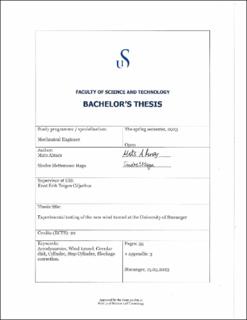| dc.description.abstract | This thesis aims to gain experience in using the newly installed CTO S.A open circuit wind
tunnel at the University of Stavanger. Extensive research has been done on the topics of
wind tunnel use, general aerodynamics, blockage-correction methods, and other methods
necessary to obtain accurate data. This thesis also presents the configuration and details of
the specific wind tunnel used.
Wind tunnel tests have been performed on several geometries, these are circular flat disks,
cylinder and step cylinder. Designing of geometries and modifications to the tunnel was
done prior to the testing.
Blockage- correction methods and other methods has been applied to the results for compar-
ison. Our results on the circular disk and cylinder is also compared to previous results from
tests on the same geometries to ultimately gain insight and usability of all the methods.
The drag characteristics of the step cylinder is compared to the drag characteristics of
uniform cylinders.
The corrected drag coefficients for the 200mm circular disks corresponds well to previous
results. However, the corrected drag coefficients for the 50, 100, and 150mm disks deviates
to a varying degree, due to unknown fault in the image method.
Comparing the corrected drag coefficients of the cylinder at different Reynolds numbers
with previous results from "two-dimensional flow" experiments reveals clear similarities.
However, the magnitude of the corrected drag coefficients appears to correspond better to
the previous results obtained for cylinders with an aspect ratio of 5. When comparing
flow separation angles on the cylinder using different techniques, inherent differences are
observed, both for laminar and turbulent boundary layer.
The step cylinder drag coefficient is overall lower compared to drag coefficient of uniform
cylinders, showing that calculating drag forces and drag coefficient can not be done accu-
rately by only combining data on forces and coefficients from "two dimensional flow". The
drag coefficient for a step cylinder will most likely be lower overall, where the extent of the
difference depends on the diameter ratios.
Conclude on the most accurate blockage- correction method can not be done with our limited
results where all seem effective. However it can be assumed that the Maskell III method is
more accurate than Maskell’s method since it also considers the wake distortion. | |
